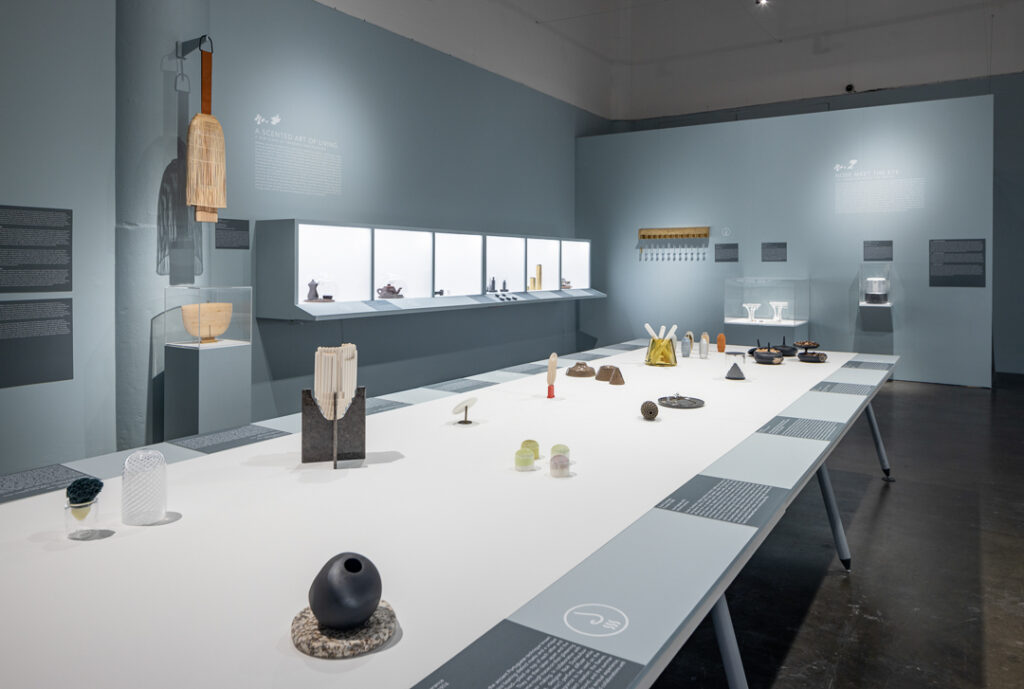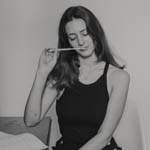
“Living With Scents”, Exhibition view, Museum of Craft and Design, San Francisco, February 12 – June 5, 2022. photo Henrik Kam
Clara Muller outlines the history of “olfactory design” and her interest in realising past dreams of a new art form.
When asked what I mean when I talk about “olfactory design”, there is always a few seconds of hesitation on my part. “How do I circumscribe this?” I ask myself. Many people would have you believe that they have coined the phrase, that they know just what it means because olfactory design is what they do. Some perfumers will call themselves “olfactory designers” to stand out and appeal to new clients. Scent marketing professionals will use the expression to define their services. Others will claim that it mostly refers to scenography, both in the field of live performance and architecture.
I am not saying that these are not valid definitions. Olfactory design is a broad term, which can encompass a wide variety of practices. But what I mean when I put together these two words is much more related to objecthood: I think about objects being designed as olfactory interfaces, connecting users and odours, allowing specific usages. And it’s not about scented markers, scratch’n’sniff stickers, perfumed dolls or other smelly gadgets either. I am much more interested in the old and new ways of mediating scents that have been invented by designers and makers from all around the globe and whose goal it has been, not only to contain and diffuse aromatic compositions, but to create inspiring objects to manipulate, use and control scents.
Although infinitely less numerous than those intended for sight and hearing, objects created to facilitate the perception and the use of aromatic substances in specific cultural contexts mark out the history of humanity all the same, yet they remain relatively unknown. If I speak of spectacles, telescopes, ear trumpets or phonographs, it is likely that everyone knows what I am referring to. But should I utter the words thymiaterion, pomander, or odoroscope, I might leave my interlocutor a bit taken aback. As a modern and contemporary art historian fascinated with the subject of smell, I could not help but indulge in a form of olfactory media archeology, researching both historical and imaginary objects intended to bring odours into various spheres.

Perfume burner or “coupe-à-socle” from Er Lannic (Arzon, Morbihan, France), neolithic period, from the Musée de Préhistoire de Carnac collections. photo L. Rannou
For a very long time, olfactory objects have been limited to three kinds of applications: religious, therapeutic, and cosmetic. If I exclude simple containers (amphoras, vases, flasks, ointment boxes, bottles, etc.), the most common olfactory instruments are undoubtedly perfume burners, predominantly used in ritual contexts. In all regions of the world, incense burners have been unearthed, the oldest ones dating back to the Neolithic period. In the Middle Ages, new kinds of objects were created. In Europe, vinaigrettes and pomanders facilitated the curative and prophylactic use of fragrant substances, while in China and Japan people used intricate incense clocks to measure time.
In the West, the second half of the nineteenth century, with the advent of modern perfumery, is also marked by the invention of numerous instruments intended to apply fragrances: perfumed fans, lance-parfums, perfume syringes, atomisers, etc. Man-made scents then soon conquered new realms, with the help of different kinds of objects. As early as 1912, an article from the Sydney Sunday Times mentions a bronze and silver “perfume lamp” intended for the furnishing of boudoirs. By the mid-1930s, such objects—of which the Lampe Berger is the most famous—were the latest fashion in Paris. With them, scents finally separated from religion, pharmacopeia and the cosmetic to enter the domestic sphere, no longer to purify the atmosphere but for simple pleasure. In 1932, a journalist from the Australian Daily News went as far as to declare the time the “Age of Perfume.” In many ways, we are still living in this age!

English Pomander, ca. 1580, from the Metropolitan Museum of Arts collections. photo Public Domain http://www.metmuseum.org/art/collection/search/205074
As my research progressed, I also became deeply interested in unrealised projects. I think there is a lot to learn in the unfinished, the fantasied, the implausible. In 1844, the French newspaper L’Illustration announced the advent of an art form intended for the sense of smell. Named “osphretic,” it would be accompanied by the development of multiple tools intended to impress the nose and mediate scents: “Can you imagine our living rooms filled with furniture and instruments intended to flatter and exalt our nasal organ?”Although the idea was widely mocked in the press during the following decades, a few attempts were made – some wackier than others – to make a reality out of these “furniture and instruments” for the nose. In 1849 for instance, a patent was filed in the United States for a rocking chair called “odoroeolian seat,” equipped with a pedal acted upon by the foot of the occupant to activate bellows and diffuse perfumes.
For more than a century, engineers and inventors, but also writers and filmmakers, competed for the prize of the most original (and most fanciful!) olfactory invention. Some projects described in fiction are particularly curious, such as the “microdor,” a device invented by writer Louis de Beaumont in 1878 and intended to expand human olfactory sensitivity, or “olfactory discs” imagined in 1923 by novelist Bernard Gervaise to diffuse smell symphonies on some sort of olfactory gramophone. Many also remember the idea of a perfume organ described by authors Kurd Lasswitz and Claës Lundin in the late nineteenth century under the name “Ododion” and then popularised by Aldous Huxley in Brave New World (1932). As for movie fans, they may recall the “Odorifics” from Al Ashby’s Harold and Maud (1971): who wouldn’t want to take a whiff out of this odd-looking device allowing its user to breathe in complex fragrant landscapes from gas cylinders?
I find this long history of olfactory objects, both real and fictitious, truly captivating, especially as it still informs the work of artists, craft makers and designers today. In the last fifteen years, creators have brought the craft of dispersion to new levels by producing objects—either industrially manufactured or carefully handcrafted—allowing us to use odours for increasingly diverse purposes: education, contemplation, devotion, home ambience, sustenance, communication, entertainment, remembrance, health and well-being, etc. Whether you want to ornate your home with a redolent tapestry (Scent objects by Zsofia Kollar), to concentrate the smell of a flower bouquet (Scent Vase by Nendo), to relax to the smell of lavender emanating directly from your furniture (Fragrance Lamp by Georgiana Ghit), to gently remind an elderly parent to have a meal (Ode by Lizzie Ostrom) or compose a scent message for a blind friend (Olfabet by Peter de Cupere), there’s now an object for that!This recent boom of olfactory items was the subject of Living with Scents, an exhibition that I co-curated last year alongside Elisabetta Pisu at the Museum of Craft and Design in San Francisco. In this unprecedented exhibition, we brought together forty-two olfactory projects, from twenty different countries, to give visitors a glimpse of the surprisingly-diverse contemporary olfactory culture embodied in these objects, and hopefully help them grasp the tremendous importance of odours in our lives. Because that’s what olfactory design, for me, is all about.
About Clara Muller
 French art historian and curator Clara Muller is pursuing research on the politics of breathing as a mode of perception in contemporary art as well as on the various creative practices involving scents. In 2022 she co-curated Living With Scents at the Museum of Craft and Design in San Francisco. She is also a writer for the olfactory magazine NEZ, published every six months in French and in English. Currently based in the small town of Sancerre in the Loire Valley, she organises wine and perfume tastings, creative writing workshops around scents and nature, and teaches yoga, additionally to her research practice. She is currently elaborating an international guide of olfactory design with the French publishing house Nez Éditions. Visit www.claramuller.fr
French art historian and curator Clara Muller is pursuing research on the politics of breathing as a mode of perception in contemporary art as well as on the various creative practices involving scents. In 2022 she co-curated Living With Scents at the Museum of Craft and Design in San Francisco. She is also a writer for the olfactory magazine NEZ, published every six months in French and in English. Currently based in the small town of Sancerre in the Loire Valley, she organises wine and perfume tastings, creative writing workshops around scents and nature, and teaches yoga, additionally to her research practice. She is currently elaborating an international guide of olfactory design with the French publishing house Nez Éditions. Visit www.claramuller.fr



